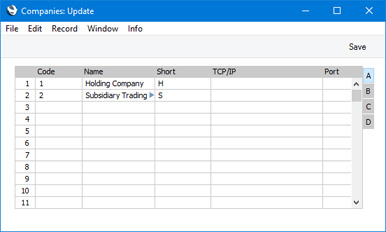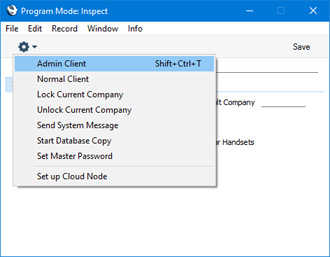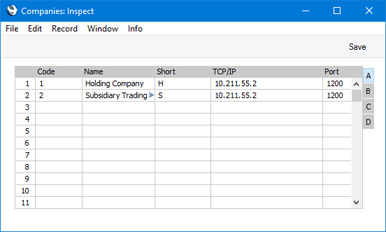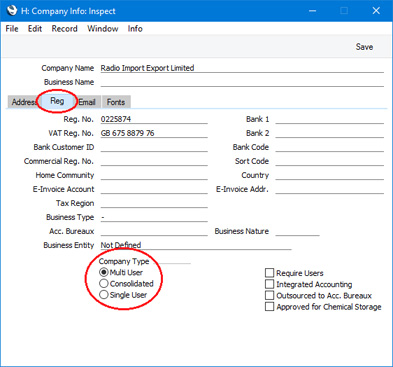Creating a New Database - Changing and Adding Companies
This page describes adding Companies to a Standard ERP database.
---
When you create a new database, it will contain a single Company, created for you automatically. You can add extra Companies at any time. You should only add extra Companies if your business is one where there are separate departments or subsidiary companies that keep separate accounts, as described on the Companies and Databases page.
Changing and Adding Companies - Single-user
If you have a single-user installation of Standard ERP, follow these steps to add extra Companies:
- Before adding extra Companies, ensure the correct number of Single User Companies has been registered in the Configuration setting.
- To be able to add Companies, you should log in as a Global User with access to all Companies. Otherwise logging in won't be possible because the new Companies won't immediately contain any user accounts. Please refer here for details about Global Users.
- Click the [Companies] button in the 'Navigation' section of the Navigation Centre:

- The 'Select Company' window opens. In the top left-hand corner, there is an [Operations] button with the following icon:

Click this button to open the Operations drop-down menu:

Select the 'Open Companies Setting' option. The 'Companies: Inspect' window will be opened:

The Company Name and Short Code in the first Company are both taken from the 'Enter Company Name' window (step 3 on the Creating a New Database - Single-user page). If these are not suitable, change them now.
- To add more Companies, click in the Code field in the first blank row and enter information as described below. Remember, this should only be done for parts of your business that are completely separate accounting entities to the first Company.
- Code
- Enter a unique code. This must be a numeric code between 1 and 99.
- Name
- Enter the company name that you want to be shown in the 'Select Company' window. This is the window where you will choose the Company you want to work with each time you log in to Standard ERP.
- Short
- If you have more than one Company in your database, you can switch between Companies in a work session, leaving windows from each Company open. This Short Code will be included in every window title to indicate the Company to which the information in the window belongs. If you only have one Company, you don't need to specify a Short Code, in which case window titles will not include a Company indicator.
- TCP/IP
- You should only use this field on client machines in multi-user systems. Leave it empty in single-user systems.
- Port
- You should only use this field on client machines in multi-user systems. Leave it empty in single-user systems.
Please refer to this page for details of the fields on flips B, C and D. You only need use the fields on flips B and D in larger multi-user systems, and those on flip C in single-user systems.
If you are creating a new Company, the "DEFAULT.TXT" text file must be present in the folder containing the Standard ERP application. Standard ERP will use this file to import some basic settings to the new Company.
Remember that each Company will maintain completely separate accounts, so there is no need to create separate Companies for departments that are part of the same accounting whole.

- When the entry is complete, click the [Save] button in the top right-hand corner of the Company screen.
- After adding each new Company, log in to it and then enter the correct name and address details as described on this page. You should do this in each Company before applying for an Enabler Key. To change Companies during a work session, simply use the Ctrl-O (alpha O) (Windows) or ⌘-O (macOS) keyboard shortcut to open the 'Select Company' window to choose a different Company. If you are not able to log in to a new Company, the probable reason is that you have not logged in as a Global User as mentioned in step 2.
Changing and Adding Companies - Multi-user
In a multi-user installation, all data is stored in the database on the server. There will also be a small database on each client, containing almost no data. If you are working on a client and you create a new record (e.g. a new Invoice) and save it, it will be saved in the server database only. This is the case for most records, but not for Companies. If you are working on a client and you create a new Company, it will be saved in the client database, not on the server. This is because the Companies in the server database and the Companies in each client database are distinct. The Companies in the server database are used to store the data relating to each Company. The Companies in a client database allow you to find a Company on the server, connect to it and log in to it.
If you need to add a new Company in a multi-user system, you need to be able to save it in the server database. To be able to do this when working from a client, you need to enter a special mode of operation known as "Admin Client" mode. When you are in "Admin Client" mode, a new Company that you add from a client will be saved in the server database.
Follow these steps:
- Before adding extra Companies, ensure the correct number of Multi User Non-Consolidated and/or Multi User Consolidated Companies has been registered in the Configuration setting. You should register your Companies as Multi User Consolidated Companies if you need their information to be included in consolidated accounting reports: please refer here for more information.
- To be able to add Companies, you should log in as a Global User with access to the Technics module and to all Companies. This will allow you to log in to the new Company or Companies after adding them. Otherwise logging in won't be possible because the new Companies won't immediately contain any user accounts. Please refer here for details about Global Users, and here for details about gaining access to the Technics module.
- You should only carry out this step if you have logged in to the server from a client. Do not do it if you are working in the server database itself.
Use the Ctrl-0 (zero) (Windows) or ⌘-0 (macOS) keyboard shortcut to open the list of modules, and double-click 'Technics'. Click the [Registers] button in the Navigation Centre and double-click 'Program Mode' in the resulting list. Choose 'Admin Client' from the Operations menu (with "cog" icon):

Selecting 'Admin Client' ensures that when you create the new Company as described in steps 5-7, you will save it in the server database. If you do not choose 'Admin Client', the new Company will be saved in the database on your client machine. The phrase "Admin Client" will be added as a suffix to the window title of the Navigation Centre.
If the Technics module is not included in the list of modules, the probable reason is that you have not logged in as a user with access to the Technics module as mentioned in step 2.
- Click the [Companies] button in the 'Navigation' section of the Navigation Centre:

- The 'Select Company' window opens. Click the [Operations] button to open the Operations drop-down menu:

Select the 'Open Companies Setting' option. The 'Companies: Inspect' window will be opened:

The Company Name and Short Code in the first Company are both taken from the 'Enter Company Name' window (step 3 on the Creating a New Database - Server page). If these are not suitable, change them now.
- To add more Companies, click in the Code field in the first blank row and enter information as described in step 5 in the 'Single-user' section above. As described in that section, leave the TCP/IP and Port fields empty.
If you are adding a new Company, the "DEFAULT.TXT" text file must be present in the folder on the server containing the Standard ERP application. Standard ERP will use this file to import some basic settings to the new Company.
Remember that each Company will maintain completely separate accounts, so there is no need to create separate Companies for departments that are part of the same accounting whole.

- When the entry is complete, click the [Save] button in the top right-hand corner of the Company screen.
- Close the Standard ERP client application and log in to the server again in order to gain access to the new Companies.
Each time you log in to the server, the Company register from the server will be copied to the database on your client machine. Included in the copying process will be the IP address of the server machine and the port specified in the Program Mode register in the server database::

- After adding each new Company, log in to it and then enter the correct name and address details as described on this page. You should do this in each Company before applying for an Enabler Key . To change Companies during a work session, simply use the Ctrl-O (alpha O) (Windows) or ⌘-O (macOS) keyboard shortcut to open the 'Select Company' window to choose a different Company. If you are not able to log in to a new Company, the probable reason is that you have not logged in as a Global User as mentioned in step 2.
- If you are working from a client machine and if you specified in step 2 that some Companies will be Multi User Consolidated, a "More Non-Consolidated Companies than allowed. Some companies are now disabled" message will appear when you log in to each Company. To address this issue, open the Company Info setting and change the Company Type to "Consolidated" on the 'Reg.' card:

—
Multi-user Installation:
Single-user Installation:
See also:
Go back to:
